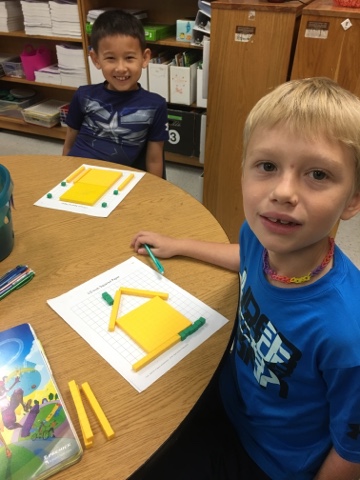This week has been full of wonderful things! The weather has cooled off, we are starting to feel "Texas fall."
In project we have learned that our senses are constantly on the move...however, our RAS (reticular activating system) acts like a filter/strainer, only letting our attention focus on some of those signals. We have active control over it -- we can choose what to focus on. We've taken sensory walks to show how, even though we have "seen" certain things many times, when we are asked to focus our attention (i.e. find orange things), suddenly everywhere we look we find those particular things.
In Second Grade reading, we have been working on a Kevin Henkes author study in tangent with summarization. They have learned CSERT to assist them in separating the details from the main idea.
We've been working on writing those correctly, with complete sentences, paragraph form, and proper letter form in writing.
Third has been reading their novel, A Long Walk to Water, and learning a new level of caring about their character. We've been working on honing our summaries to contain only essential information, and to express them by paraphrasing. Our narrative is in revision/critique stages, and we are working to craft with precision and description.
Fourth Grade is nearing the end of Fish in a Tree, and experienced a taste of what a dyslexic reader may experience in "cracking the code." It was eye opening to see how difficult and frustrating it can be to not be able to understand what is on paper. We have been learning about simple and compound sentences in writing -- FANBOYS is our mnemonic to remember our coordinating conjunctions. They have also begun outlining expository writing.
In math fourth graders learned another strategy when comparing two fractions. The strategy is finding the common denominator by multiplying the denominators by the numerators and then multiplying the two denominators together. They practiced the four strategies they know by playing four corners in the classroom. They moved to the corner in the room to show which strategy they used when comparing fractions. They also used ordered pairs to plot points on graph paper that made a pumpkin picture.
Third graders used hundreds charts to highlight the multiples 2-12. They wrote the times tables for that multiple and the patterns they saw on the chart. Have your child to tell you what the factors, product, and multiples are in a multiplication equation. 3 X 4 = 12 We also made multiplication haunted houses.
Second graders solved multi-step story problems that involved addition and subtraction this week. They wrote equations that went along with the story problem and they also wrote their own story problems. We had fun making haunted place value mansions on Friday.
In project we have learned that our senses are constantly on the move...however, our RAS (reticular activating system) acts like a filter/strainer, only letting our attention focus on some of those signals. We have active control over it -- we can choose what to focus on. We've taken sensory walks to show how, even though we have "seen" certain things many times, when we are asked to focus our attention (i.e. find orange things), suddenly everywhere we look we find those particular things.
In Second Grade reading, we have been working on a Kevin Henkes author study in tangent with summarization. They have learned CSERT to assist them in separating the details from the main idea.
We've been working on writing those correctly, with complete sentences, paragraph form, and proper letter form in writing.
Third has been reading their novel, A Long Walk to Water, and learning a new level of caring about their character. We've been working on honing our summaries to contain only essential information, and to express them by paraphrasing. Our narrative is in revision/critique stages, and we are working to craft with precision and description.
Fourth Grade is nearing the end of Fish in a Tree, and experienced a taste of what a dyslexic reader may experience in "cracking the code." It was eye opening to see how difficult and frustrating it can be to not be able to understand what is on paper. We have been learning about simple and compound sentences in writing -- FANBOYS is our mnemonic to remember our coordinating conjunctions. They have also begun outlining expository writing.
In math fourth graders learned another strategy when comparing two fractions. The strategy is finding the common denominator by multiplying the denominators by the numerators and then multiplying the two denominators together. They practiced the four strategies they know by playing four corners in the classroom. They moved to the corner in the room to show which strategy they used when comparing fractions. They also used ordered pairs to plot points on graph paper that made a pumpkin picture.
Third graders used hundreds charts to highlight the multiples 2-12. They wrote the times tables for that multiple and the patterns they saw on the chart. Have your child to tell you what the factors, product, and multiples are in a multiplication equation. 3 X 4 = 12 We also made multiplication haunted houses.
Second graders solved multi-step story problems that involved addition and subtraction this week. They wrote equations that went along with the story problem and they also wrote their own story problems. We had fun making haunted place value mansions on Friday.



Comments
Post a Comment